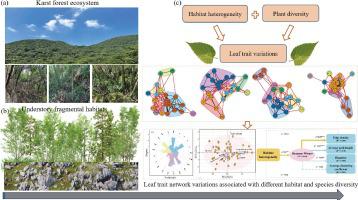当前位置:
X-MOL 学术
›
Ecol. Indic.
›
论文详情
Our official English website, www.x-mol.net, welcomes your feedback! (Note: you will need to create a separate account there.)
Leaf trait network variations with woody species diversity and habitat heterogeneity in degraded karst forests
Ecological Indicators ( IF 6.9 ) Pub Date : 2024-03-20 , DOI: 10.1016/j.ecolind.2024.111896 Jiawei Yan , Yuejun He , Min Jiao , Yun Guo , Peiyun Xie , Danmei Chen , Qingfu Liu , Yuan Liu , Pan Wu
Ecological Indicators ( IF 6.9 ) Pub Date : 2024-03-20 , DOI: 10.1016/j.ecolind.2024.111896 Jiawei Yan , Yuejun He , Min Jiao , Yun Guo , Peiyun Xie , Danmei Chen , Qingfu Liu , Yuan Liu , Pan Wu

|
Leaf Trait Networks (LTNs) visually display the intricate trait connections in offering insights into how plants adapt to diverse environments. The pervasive environmental heterogeneity can influence plant diversity and functional traits. Various habitats sustain distinct species diversity and leaf trait differentiation, precisely as the degraded karst-heterogenous ecosystem caused by inhomogeneous microhabitats. However, how the LTNs respond to understory habitat heterogeneity and species diversity in degraded karst forests remains unclear. This study selected fifty-three forest plots for plant community survey and habitat investigation in a typical karst topography to visualize LTNs using twenty-one woody leaf traits. LTN architecture variations were analyzed in relation to habitat heterogeneity and species diversity through network-architectural parameters, including edge density, diameter, average path length, and average clustering coefficient, utilizing regression, principal component analysis, and structural equation model. The results showed a 35% variation in modularity across all plots, indicating distinct network architectural modularization differentiation. Network diameter and average path length displayed significant initial decreases followed by increases with ascending PC1 heterogeneity scores, indicating moderate heterogeneity sustained greater network connectivity. In addition, the network diameter, average path length, and average clustering coefficient significantly decreased with increasing species diversity, indicating that high species diversity enables greater connectivity and complexity. Moreover, the habitat heterogeneity significantly affected species diversity directly and affected the average clustering coefficient, diameter, average path length, and edge density indirectly through species diversity effects via SEM pathway analysis. Overall, habitat heterogeneity and woody plant diversity of karst forests significantly influence LTN architectures in degraded karst forests. In conclusion, moderate heterogeneity sustains greater network connectivity while species diversity jointly enhances connectivity and complexity by combining modular regulation of plant functional traits.
中文翻译:

退化喀斯特森林叶性状网络随木本物种多样性和生境异质性的变化
叶子性状网络(LTN)直观地显示了复杂的性状联系,从而深入了解植物如何适应不同的环境。普遍存在的环境异质性会影响植物多样性和功能性状。不同的生境维持着不同的物种多样性和叶片性状分化,正如不均匀的微生境导致喀斯特异质生态系统退化一样。然而,LTN 如何响应退化喀斯特森林中的林下生境异质性和物种多样性仍不清楚。本研究选择了 53 个森林地块,在典型的喀斯特地形中进行植物群落调查和栖息地调查,以使用 21 个木本叶子性状可视化 LTN。利用回归、主成分分析和结构方程模型,通过网络架构参数(包括边缘密度、直径、平均路径长度和平均聚类系数)分析 LTN 架构变化与栖息地异质性和物种多样性的关系。结果显示,所有图中的模块化程度存在 35% 的差异,表明网络架构模块化差异明显。网络直径和平均路径长度最初表现出显着下降,随后随着 PC1 异质性得分的上升而增加,表明中等异质性维持了更大的网络连接性。此外,随着物种多样性的增加,网络直径、平均路径长度和平均聚类系数显着下降,这表明高物种多样性可以实现更大的连通性和复杂性。此外,生境异质性直接显着影响物种多样性,并通过SEM路径分析通过物种多样性效应间接影响平均聚类系数、直径、平均路径长度和边缘密度。总体而言,喀斯特森林的生境异质性和木本植物多样性显着影响退化喀斯特森林的LTN结构。总之,适度的异质性维持了更大的网络连通性,而物种多样性通过结合植物功能性状的模块化调节共同增强了连通性和复杂性。
更新日期:2024-03-20
中文翻译:

退化喀斯特森林叶性状网络随木本物种多样性和生境异质性的变化
叶子性状网络(LTN)直观地显示了复杂的性状联系,从而深入了解植物如何适应不同的环境。普遍存在的环境异质性会影响植物多样性和功能性状。不同的生境维持着不同的物种多样性和叶片性状分化,正如不均匀的微生境导致喀斯特异质生态系统退化一样。然而,LTN 如何响应退化喀斯特森林中的林下生境异质性和物种多样性仍不清楚。本研究选择了 53 个森林地块,在典型的喀斯特地形中进行植物群落调查和栖息地调查,以使用 21 个木本叶子性状可视化 LTN。利用回归、主成分分析和结构方程模型,通过网络架构参数(包括边缘密度、直径、平均路径长度和平均聚类系数)分析 LTN 架构变化与栖息地异质性和物种多样性的关系。结果显示,所有图中的模块化程度存在 35% 的差异,表明网络架构模块化差异明显。网络直径和平均路径长度最初表现出显着下降,随后随着 PC1 异质性得分的上升而增加,表明中等异质性维持了更大的网络连接性。此外,随着物种多样性的增加,网络直径、平均路径长度和平均聚类系数显着下降,这表明高物种多样性可以实现更大的连通性和复杂性。此外,生境异质性直接显着影响物种多样性,并通过SEM路径分析通过物种多样性效应间接影响平均聚类系数、直径、平均路径长度和边缘密度。总体而言,喀斯特森林的生境异质性和木本植物多样性显着影响退化喀斯特森林的LTN结构。总之,适度的异质性维持了更大的网络连通性,而物种多样性通过结合植物功能性状的模块化调节共同增强了连通性和复杂性。



























 京公网安备 11010802027423号
京公网安备 11010802027423号